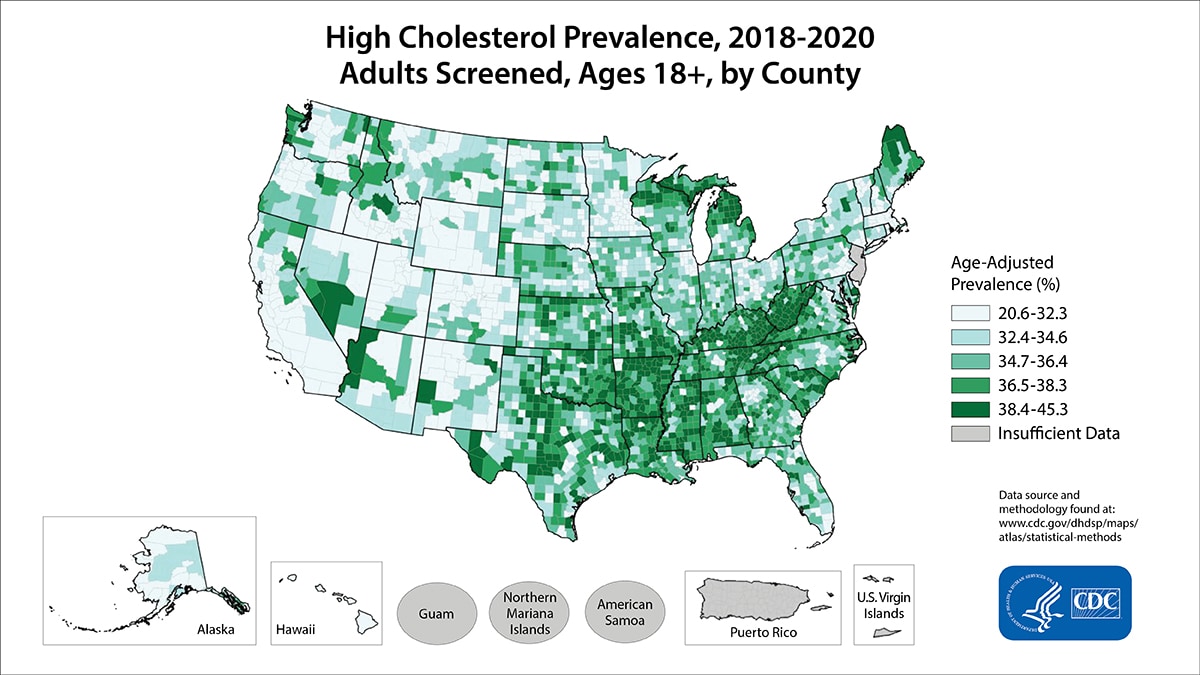Key points
High total cholesterol is 240 mg/dL or more. High cholesterol has no symptoms, so many people don’t know that their cholesterol is too high. A simple blood test can check cholesterol levels.

High total cholesterol in the United States
- Between 2017 and 2020, 10% of adults age 20 or older had total cholesterol levels above 240 mg/dL. About 17% had high-density lipoprotein (HDL, or "good") cholesterol levels below 40 mg/dL.1
- Slightly more than half of US adults (54.5%, or 47 million people) who could benefit from cholesterol medicine are currently taking it.2
- About 86 million US adults age 20 or older have total cholesterol levels above 200 mg/dL. Nearly 25 million adults in the United States have total cholesterol levels above 240 mg/dL.1
- About 7% of US children and adolescents ages 6 to 19 have high total cholesterol.3

Who is affected
High total cholesterol levels vary by race/ethnicity and sex
The chart below shows the prevalence of high total cholesterol (240 mg/dL or more) among adults age 20 and older in the United States from 2017 to 2020.1
Racial or Ethnic Group
Males, %
Females, %
Non-Hispanic Black Adults
6.9
9.3
Hispanic Adults
9.3
10.0
Non-Hispanic White Adults
9.6
10.7
Non-Hispanic Asian Adults
13.0
8.7
People in the United States are making progress on high cholesterol
About two thirds of US adults say they have had their cholesterol checked within the last 5 years.4
Most healthy adults should have their cholesterol checked every 4 to 6 years. Some people, such as those who have heart disease, diabetes, or a family history of high cholesterol, need to get their cholesterol checked more often.5
- Tsao CW, Aday AW, Almarzooq ZI, Beaton AZ, Bittencourt MS, Boehme AK, et al. Heart Disease and Stroke Statistics—2023 Update: A Report From the American Heart Association. Circulation. 2023;147:e93–e621.
- Wall HK, Ritchey MD, Gillespie C, Omura JD, Jamal A, George MG. Vital Signs: prevalence of key cardiovascular disease risk factors for Million Hearts 2022—United States, 2011–2016. Morbidity and Mortality Weekly Report. 2018;67(35):983–991.
- Perak AM, Ning H, Kit BK, de Ferranti SD, Van Horn LV, Wilkins JT, Lloyd-Jones DM. Trends in levels of lipids and apolipoprotein B in US youths aged 6 to 19 Years, 1999–2016. JAMA. 2019;321(19):1895–1905.
- Carroll MD, Kit BK, Lacher DA, Yoon SS. Total and High-Density Lipoprotein Cholesterol in Adults: National Health and Nutrition Examination Survey, 2011–2012 [PDF – 778K]. NCHS data brief, no. 132. Hyattsville, MD: National Center for Health Statistics; 2013.
- HealthFinder.gov. Get Your Cholesterol Checked. Washington, DC: U.S. Department of Health and Human Services; 2018.
